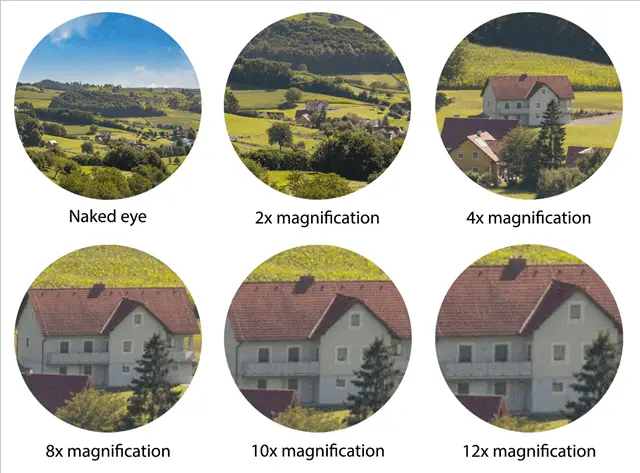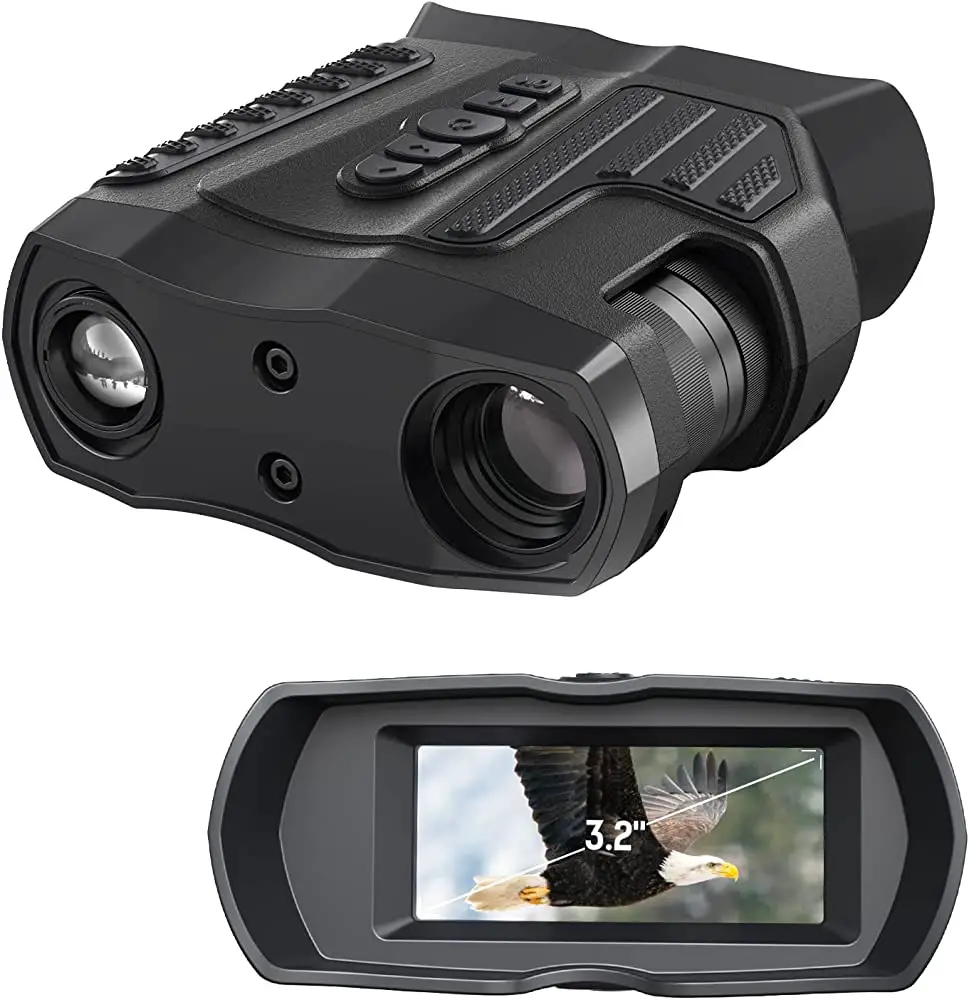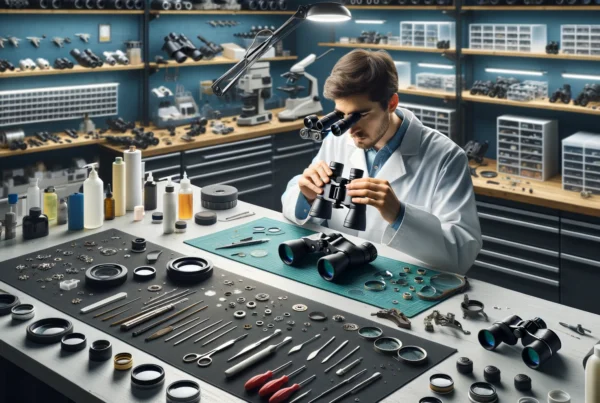Contents
- The Lowdown on Magnification:
- 8x Magnification: A Balanced Perspective:
- 10x Magnification: Up Close and Personal:
- Beyond 10x: Extreme Magnification:
- Low Magnification Binoculars: Widening Your View:
- Medium Magnification Binoculars: Striking a Balance:
- High Magnification Binoculars: Getting Close and Personal
- Optical Magnification: Traditional and Portable
- Digital Magnification: Harnessing the Power of Technology
- Electronic Magnification (CCTV): Unveiling Clarity and Customization
- Telescopic Systems: Bringing the Distant Closer
- Considerations for Choosing the Right Magnification Option:
- Frequently Asked Questions (FAQs)
- Bottom Line
Have you ever found yourself in awe of nature’s beauty, wanting to get a closer look at distant birds soaring through the sky or marveling at the intricate details of a breathtaking landscape? Binoculars can be your trusty companion in these moments, but understanding the pros and cons of different magnification options is key to choosing the perfect pair.
Binoculars provide enhanced magnification for distant objects, allowing for clear and detailed viewing. They offer portability and versatility but may have a limited field of view and require proper adjustment for optimal performance. Consider individual preferences and specific visual requirements when choosing binoculars as a magnification option.
Join us on a journey as we explore the world of binocular magnification and unravel the benefits and drawbacks each option presents.
The Lowdown on Magnification:
Magnification is the essence of binoculars, allowing us to bring distant objects closer. It is denoted by a number, such as 8x or 10x, indicating how many times the object is magnified. Let’s dive into the pros and cons of different magnification options.
8x Magnification: A Balanced Perspective:
At 8x magnification, binoculars strike a balance between enlarging the view and maintaining a wide field of view. This option offers several advantages:
Pros:
- Wide field of view: Capturing a broad area, ideal for scenic landscapes and fast-moving subjects.
- Less susceptible to hand shake: Higher magnifications can amplify hand movements, resulting in shaky images.
- Enhanced depth of field: Objects at different distances remain in focus, providing a three-dimensional feel.
Cons:
- Limited magnification power: Distant subjects may not appear as close as desired, limiting intricate observations.

Find out the best binocular options in 7x- 8x Range:
10x Magnification: Up Close and Personal:
Stepping up to 10x magnification brings you even closer to the action. Here’s what you can expect:
Pros:
- Detailed observations: Fine details become more apparent, perfect for birdwatching or studying wildlife.
- Greater reach: Objects appear larger, allowing for better identification of faraway subjects.
Cons:
- Narrower field of view: With higher magnification, the field of view becomes narrower, making it challenging to track fast-moving objects.
- Increased hand shake effect: Hand movements become more noticeable, potentially affecting image stability.
- Reduced depth of field: Focus may be more critical, making it trickier to keep multiple objects in focus simultaneously.
Find out the best binocular options in 10X Range:
Beyond 10x: Extreme Magnification:
For those seeking extreme magnification, options like 12x or 16x are available. However, it’s important to consider their pros and cons:
Pros:
- Incredible detail: Even the finest intricacies of distant objects become visible, making it ideal for astronomy or long-distance observation.
Cons:
- Highly sensitive to hand shake: Holding steady becomes challenging, often requiring the use of a tripod or stabilization device.
- Limited field of view: The narrow field can restrict the overall scene captured, demanding more precise aiming.
- Reduced brightness and image stability: Higher magnification can reduce the amount of light reaching your eyes, resulting in dimmer images, and making small movements more noticeable.
Low Magnification Binoculars: Widening Your View:
Low magnification binoculars, typically ranging from 7x to 10x, provide a wider field of view, making them ideal for activities where capturing a broad perspective is important. Here are the pros and cons of low magnification binoculars:
Pros:
- Wide field of view allows for easier tracking of moving objects.
- Reduced image shake due to lower magnification.
- Better depth perception and spatial awareness.
- Generally lighter and more compact, enhancing portability.
Cons:
- Objects appear less magnified, limiting the ability to observe fine details.
- Limited suitability for long-distance observations.
- Challenging to view small or distant objects with sufficient clarity.
Medium Magnification Binoculars: Striking a Balance:
Medium magnification binoculars, typically ranging from 10x to 12x, strike a balance between field of view and magnification power. They offer versatility for a wide range of applications. Let’s explore their pros and cons:
Pros:
- Enhanced magnification for observing distant objects in greater detail.
- Suitable for various activities like wildlife observation, sports events, and general use.
- Reasonable field of view, allowing for a balance between magnification and spatial awareness.
Cons:
- Slightly reduced field of view compared to low magnification binoculars.
- Image stabilization may be required to minimize shakiness.
- Relatively larger and heavier than low magnification binoculars, affecting portability.

High Magnification Binoculars: Getting Close and Personal
High magnification binoculars, typically ranging from 12x and above, offer an exceptional level of magnification for detailed observations. Here are the pros and cons of high magnification binoculars:
Pros:
- Powerful magnification for detailed observations of distant objects.
- Ideal for astronomy, nature spotting, and long-range surveillance.
- Can reveal intricate details that may not be visible with lower magnification binoculars.
Cons:
- Narrow field of view, requiring precise aiming and making it challenging to track fast-moving objects.
- Increased image shake, necessitating the use of image stabilization or tripod support.
- Bulkier and heavier than lower magnification binoculars, affecting portability and ease of use.
Do you know what’s the highest magnification for a binocular? Find out here.
Optical Magnification: Traditional and Portable
Optical magnification in binoculars offers a traditional approach to viewing, relying solely on the optics and lenses without the need for technology. Here are the pros and cons of optical magnification:
Pros:
- Provide a natural and direct view without relying on technology: Optical magnification offers a more organic viewing experience as it utilizes the principles of lenses and optics to enhance the image. This can result in a more authentic and immersive viewing experience.
- Can be used in various outdoor environments without the need for power sources: Unlike digital or electronic options, optical magnification does not require batteries or electricity to operate. This makes it suitable for outdoor activities where power sources may not be readily available.
Cons:
- Limited magnification levels compared to digital or electronic options: Optical magnification is often limited in terms of the maximum level of magnification it can provide. This means that it may not be suitable for situations that require extremely high levels of magnification, such as observing distant celestial objects or detailed wildlife observation.
- Restricted field of view may require constant repositioning: Binoculars with optical magnification typically have a narrower field of view compared to digital or electronic options. This means that to view a broader area, users may need to frequently reposition the binoculars or pan across the scene. It can be inconvenient in situations where a wide field of view is desired, such as observing landscapes or fast-moving subjects.
Digital Magnification: Harnessing the Power of Technology
Digital magnification in binoculars involves the use of technology, such as cameras and electronic screens, to enhance the viewing experience. Let’s explore the pros and cons of digital magnification:

Pros:
- Adjustable magnification levels for greater flexibility: Digital magnification allows users to adjust the level of magnification according to their specific needs. This flexibility enables customization based on the distance and size of the objects being observed.
- Some models offer additional features like image stabilization or image enhancement: Digital binoculars often come with additional features that enhance the viewing experience. Image stabilization reduces hand tremors, resulting in a steadier view, while image enhancement features can improve image clarity, contrast, and color reproduction.
Cons:
- Dependence on power sources (batteries or electricity): Digital magnification requires a power source, such as batteries or electricity, to operate the electronic components involved. Users need to ensure they have a reliable power supply or carry spare batteries to sustain the usage, which can be a limitation in remote or prolonged outdoor activities.
- Quality of magnification may vary based on the device’s screen resolution and image processing algorithms: The effectiveness of digital magnification depends on the quality of the device’s screen resolution and the image processing algorithms used. Lower-resolution screens or suboptimal image processing can result in a degraded image quality, affecting the overall viewing experience.
Electronic Magnification (CCTV): Unveiling Clarity and Customization
Electronic magnification in binoculars combines advanced optics with electronic components to provide high levels of magnification. Let’s explore the pros and cons of electronic magnification:
Pros:
- High levels of magnification surpassing optical and digital options: Electronic magnification often offers higher levels of magnification compared to optical or digital options. This makes it suitable for detailed observations of distant objects, such as celestial bodies or fine details in nature.
- Customization options for contrast adjustment and color filtering: Electronic binoculars often provide customization options to adjust contrast levels and apply color filters. These features can enhance visibility and optimize the viewing experience for individuals with specific visual needs.
Cons:
- Less portable and bulkier compared to other options: Electronic magnification typically requires additional components and electronics, making the binoculars bulkier and less portable. This can be a consideration for users who prioritize compactness and ease of carrying during outdoor activities.
- Higher cost investment: Electronic binoculars with advanced magnification capabilities tend to be more expensive compared to optical or digital options. The higher cost may limit accessibility for some individuals or be a factor to consider when budgeting for binoculars.
- Requires a power source and dedicated workspace for comfortable usage: Electronic magnification relies on a power source, such as batteries or electricity, to operate the electronic components effectively. Additionally, due to their larger size and potential complexity, electronic binoculars may require a dedicated workspace for comfortable usage and adjustment.
Telescopic Systems: Bringing the Distant Closer
Telescopic systems in binoculars provide specialized magnification for distant objects, making them suitable for outdoor activities that require long-range observation. Let’s explore the pros and cons of telescopic systems:

Pros:
- Enables magnification for distant objects, suitable for outdoor activities: Telescopic systems offer powerful magnification capabilities, allowing users to observe distant objects with clarity. This makes them ideal for activities such as birdwatching, wildlife observation, or observing celestial bodies.
- Provides greater mobility and independence: Telescopic binoculars can be handheld or mounted on wearable devices, offering mobility and flexibility during outdoor adventures. They allow users to explore vast landscapes or engage in activities that require constant movement.
Cons:
- Limited field of view, challenging in crowded environments: Telescopic systems generally have a narrower field of view, which can make it challenging to observe large areas or navigate crowded environments. This limitation may require users to reposition or adjust their viewing angles frequently.
- Requires adjustment and alignment for optimal use: Achieving optimal performance with telescopic binoculars often requires precise adjustment and alignment. Users need to align the optics correctly, focus on the desired object, and make adjustments for factors like distance and lighting conditions. This may involve a learning curve and practice to achieve the best viewing experience.
- Higher cost compared to other magnification options: Due to their advanced optical systems and specialized design, telescopic binoculars tend to be more expensive compared to other magnification options. The higher cost may be a factor to consider when budgeting for binoculars.
Considerations for Choosing the Right Magnification Option:
When selecting binoculars, it’s essential to consider the specific activities and environments in which they will be used. Here are some key factors to consider:
- Purpose: Determine the primary use of the binoculars, whether it’s birdwatching, astronomy, or general observations.
- Field of View: Assess the importance of a wide field of view versus higher magnification.
- Stability: Consider the need for image stabilization or tripod support, especially with higher magnification binoculars.
- Portability: Evaluate the weight and size of the binoculars, as it can impact comfort and ease of use.
- Budget: Determine the budget range and explore options within that range.
Frequently Asked Questions (FAQs)
Q: What are the advantages of using binoculars for magnification?
A: Binoculars offer several advantages, including enhanced depth perception, a wider field of view, and the ability to view distant objects in detail. They are portable and versatile, making them suitable for various activities such as bird watching, stargazing, or sporting events.
Q: Are there any limitations to using binoculars for magnification?
A: While binoculars provide many benefits, they also have limitations. The higher the magnification, the narrower the field of view becomes. This means that it may be challenging to track fast-moving objects or view large areas at once. Additionally, binoculars can be bulkier and heavier than other magnification options, affecting portability.
Q: Can I use binoculars without eyeglasses if I have visual impairments?
A: Binoculars can be used without eyeglasses for individuals with visual impairments. However, those with prescription eyeglasses may need to adjust the focus or use binoculars with adjustable eyecups to accommodate their specific visual needs. It is recommended to try different options and consult with an optometrist if necessary.
Q: Are there different types of binoculars available for different purposes?
A: Yes, there are various types of binoculars designed for different purposes. Some binoculars are specifically optimized for bird watching, astronomy, or outdoor activities, while others are more general-purpose. It’s important to consider the specific activities and environments in which the binoculars will be used to choose the most suitable type.
Q: Can binoculars be used by individuals with severe visual impairments?
A: Binoculars may not be the most effective magnification option for individuals with severe visual impairments. While they can provide some level of magnification, individuals with significant visual impairments may benefit more from electronic magnification devices, which offer higher levels of magnification and additional features tailored to low vision needs.
Q: How do I choose the right magnification power for binoculars?
A: The appropriate magnification power for binoculars depends on the intended use. Lower magnification, such as 7x or 8x, provides a wider field of view and better stability. Higher magnification, such as 10x or 12x, offers greater detail but may be more challenging to hold steady. Consider the intended purpose, personal preferences, and stability when selecting the magnification power for binoculars.
Bottom Line
When it comes to selecting the right magnification for your binoculars, it all boils down to your specific needs and preferences. Whether you prioritize a wider field of view, intricate detail, or extreme magnification, each option has its own set of pros and cons. Remember to consider factors such as hand steadiness, field of view requirements, and the intended use of your binoculars.

A Binoculars enthusiast, who love exploring skies and watching birds. It is my hobby to collect Binoculars of different kinds and try to explore the world through various lenses. This is all I do to explore happiness by magnifying my beautiful world.




